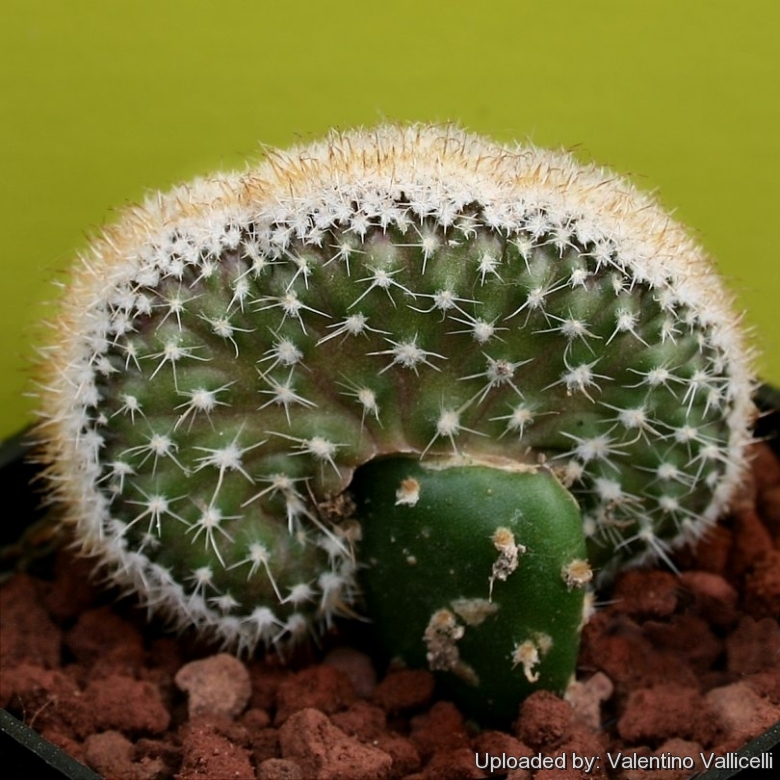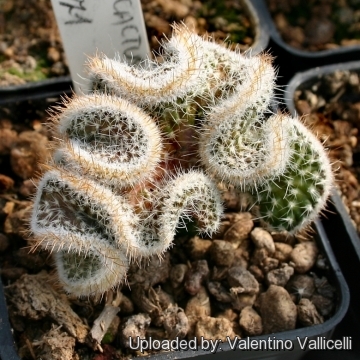
Sclerocactus whipplei f. cristatus Photo by: Valentino Vallicelli
Origin and Habitat: Garden origin (Nursery produced cultivar). Wild populations occurs in Northern Arizona and at one location near Bluff, Southeastern Utah.
Synonyms:
See all synonyms of Sclerocactus whipplei
Description: Sclerocactus whipplei is one of the more distinctive species, characterized by yellow flowers and flattened, somewhat daggerlike central spine directed toward the stem apex. The crested form Sclerocactus whipplei f. cristatusis is still very rare.
Stem: Fan shaped, forming tangled, convolute brain like mounds, it is a fast growing but often short lived form.
Ribs: (8-)13 to 15 often spiralled, prominent, tubercles usually evident on ribs.
Roots: The root systems are fibrous and shallow.
Spines: On seedlings all radials, but on old plants both radials and centrals.
Radial spines: Stouter the the radials, (5-)7-12 per areole, somewhat fattened, spreading or slightly recurved, white except for abaxial 2 that are usually purplish pink to black, (6-)12-25 mm long.
Central spines: 4(-5) per areole, terete to angled; The lowermost central spine 1 per areole, purplish pink or reddish brown, somewhat angled, hooked, 16-45(-55) long; lateral central spines 2 per areole, directed toward stem apex, purplish pink to white, 14-45 mm long; uppermost central spine white, usually flattened, straight, ribbonlike or dagger-shaped, 17-65(-70) long.
Flowers: 3 to 5 cm long, from near the the centre of the plant, often abundant, showy; funnelform to campanulate usually yellowish (or sometime - var. roseus ?- light purple or pinkish). Outer perianth segments with greenish or reddish midstripes and yellow margins, oblanceolate, to 24 mm long and 5 mm broad. Inner perianth segments yellow, oblanceolate, to 30 mm long and 6 mm broad: Tube very short. Stamens numerous with yellow (or sometime lavender) filaments, anthers yellow. Style puberulent, ovary minutely papillate, appearing smooth. They are generally bisexual and are pollinated by insects.
Blooming season: Spring (in habitat late April to June)
Fruits: Large dry or fleshy many-seeded berry, green to tan, almost naked, often reddish at maturity, ovoid, 10-25 long, 6-15 mm in diameter, scales few, yaline, scarious, margined, minutely toothed, membranous-fringed, each bearing in its axil a small tuft of hairs. Seeds release from splits in the base of the fruit.
Seeds: black, 2 mm long 2(-3) mm broad, shiny, much more larger at the upper end than at the lower. Testa with rounded papillae hylum large, lateral on the lower half of the seed.
Subspecies, varieties, forms and cultivars of plants belonging to the Sclerocactus whipplei group
 Sclerocactus whipplei f. cristatus Photo by: Valentino Vallicelli
Sclerocactus whipplei f. cristatus Photo by: Valentino VallicelliSend a photo of this plant.The gallery now contains thousands of pictures, however it is possible to do even more. We are, of course, seeking photos of species not yet shown in the gallery but not only that, we are also looking for better pictures than those already present.
Read More... Cultivation and Propagation: Although regarded as a choice and difficult plant is not too difficult in a greenhouse, although grows quite slowly.
Soil: Use mineral well permeable mineral soil without or with very little organic matter (peat, humus).
Exposure: They need a good amount of light shade to full sun this help to keep the plants healthy, although slow growth.
Watering: Water sparingly from March till October, if the weather is sunny enough. No water during cold winter months, or when night temperatures remain below 10° to prevent root loss. It is very sensitive to overwatering (rot prone).
Fertilization: Feeding may not be necessary at all if the compost is fresh then, feed in summer only if the plant hasn't been repotted recently. Do not feed the plants from September onwards as this can cause lush growth which can be fatal during the darker cold months.
Hardiness: Keep perfectly dry in winter at temperatures from 5 to 15 degrees centigrade. (but it is relatively cold resistant and hardy to -15° C, or possibly colder for short periods) In the rest period no high atmospheric humidity!! (Temperature Zone: USDA 8-10)
Propagation: Grafting or cuttings. Plants are usually grafted onto column-shaped cacti but proved to be able to produce their own roots if degrafted. Cuttings will root better in hot weather. Cuttings must be kept quite dry to root and must be placed on the soil surface without burying the plant base down in the soil.












